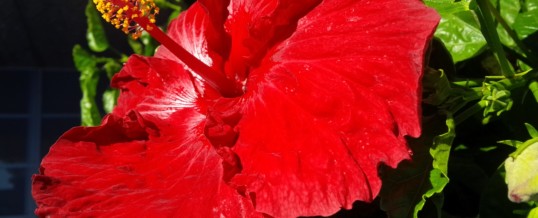
While not a typical indoor tropical plant, we thought we would provide some tips on Hibiscus care. At this time of the year, we are asked about this plant almost daily on our rounds. HIbiscus are one of the most popular flowering tropical plants purchased in the spring for terraces and decks. With such a vast array of forms and varieties, there is a Hibiscus for almost every gardening project.
The much-loved Hibiscus is the national flower of Haiti, Malaysia, and South Korea. It is the state flower of Hawaii. It is native to tropical and sub-tropical regions throughout the world, and is imported for landscaping almost everywhere. There are over 200 species of Hibiscus, and new varieties are being cultivated yearly. The Hibiscus offered at garden centers in the GTA are annuals. They can be put outside when the danger of frost has passed, and will bloom continuously until very late fall. We are often asked if they can be brought inside for the winter. It is possible, but the conditions need to be ideal. Most often the plant does poorly, as it does not tolerate the dry air of a heated building in the winter. They do best in very high humidity. It may recover once put outside the following spring, but usually does not ever look as nice as a fresh plant. We usually recommend purchasing new Hibiscus every year.
Hibiscus are grown in tree forms, sometimes with intricate braided trunks. They are available from 4ft in height to 10-12 ft. in height. The trees look best displayed in containers. Bush forms look great in garden beds. The flowers can be deep red, pale to intense pink, yellow, white, pale peach to deep orange, and bi-colour. Newer varieties have double blooms. Hibiscus require considerable sun to ensure continuous blooming. When we are asked why a Hibiscus is not blooming, it usually turns out they are not in enough light. Because they like intense light, the soil will dry out quickly. It is critical to keep Hibiscus moist. In the hottest part of the summer, they may require water every day. Although they need to be moist, they need to be in a container or garden bed with good drainage. If the roots sit in water even for a short period of time, they will rot and the plant will quickly die. High quality tropical plant soil will hold water, but drain well. Regular fertilizing with a high quality fertilizer specific for flowering tropical plants will also encourage blooms. This plant is susceptible to aphids. Inspect the plant regularly, especial the new growth. Aphids are tiny crawling green or black insects that cluster around the new growth. At the first sign of the insect, treat the plant regularly with a product specific for aphids, available at quality garden centers.
ShareJUN
2017
